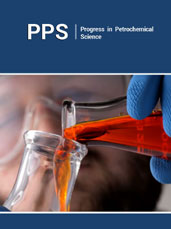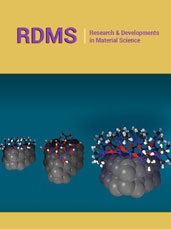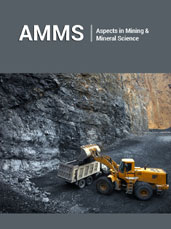- Submissions

Full Text
Progress in Petrochemical Science
Effect of 6PPD in Dynamic Properties of Tyre Sidewall Compound: An Investigation
Arnab Dutta, Ajay C*, Sumit Singha Roy, Sudeep Dey, Sanjit Kumar Das, Barun Kumar Samui, Saikat Das Gupta and Rabindra Mukhopadhyay
Hari Shankar Singhania Elastomer and Tyre Research Institute (Hasetri), India
*Corresponding author:Ajay C, Hari Shankar Singhania Elastomer and Tyre Research Institute (Hasetri), India
Submission: January 27, 2025;Published: February 14, 2025

ISSN 2637-8035Volume7 Issue 1
Abstract
Diene elastomers, such as Natural Rubber (NR) and Polybutadiene Rubber (BR), are extensively used in dynamic applications like tyres, conveyor belts and dampers due to their exceptional elasticity and durability. However, these rubber materials contain unsaturated double bonds, which are prone to degradation caused by oxygen and ozone exposure. NR, BR and their blends are typically formulated with active antiozonants to address this challenge. These additives protect against ozone cracking and oxidative damage while significantly improving fatigue resistance under dynamic conditions. The relationship between antiozonants and the dynamic properties of rubber, particularly their effect on tyre hysteresis, has been a focus of extensive research in the rubber industry. This study examines how antiozonant formulations influence the performance of diene rubber vulcanizates, highlighting their role in enhancing durability and optimizing energy efficiency in applications involving repeated stress
Introduction
The tyre industry has long been focused on improving fuel efficiency to address the dual challenges of escalating fuel costs and growing environmental concerns. This search has become even more critical with the rise of Electric Vehicles (EVs), which require low rolling resistance tyres to maximize the driving range provided by their batteries [1]. Over the past few decades, silica-based technologies have revolutionized tyre performance, particularly in tread applications. Silica reduces mechanical energy dissipation, contributing to improved fuel economy and safety. Additionally, silane coupling agents, such as 3,3’-bis(triethoxy-silylpropyl) Tetra Sulfide (TESPT), play a crucial role in ensuring effective dispersion and interaction of highly dispersible silica with rubbers [2]. These interactions enable tyre treads to achieve superior energy efficiency and durability performance. While the advantages of silica are well-established for tread compounds, its impact on non-tread components, particularly those heavily composed of natural rubber, is less significant. NR remains the preferred rubber for Truck and Bus Radial (TBR) tyres due to its outstanding crack growth resistance and tear strength-essential for withstanding the demanding conditions of non-tread applications like sidewalls. Sidewalls experience constant flexing during tyre operation, which makes them vulnerable to ozone-induced cracking. To counteract this degradation, sidewall compounds are typically formulated with higher concentrations of antiozonants [3]. The use of antiozonants in non-tread components not only extends the lifespan of these parts but also impacts the tyre’s overall performance. Studies have shown that non-tread components contribute significantly to rolling resistance, with sidewalls alone accounting for approximately 20% of the total energy losses in a tyre [4]. This makes the sidewall a critical target for optimization to achieve better fuel efficiency. Furthermore, sidewall performance has a direct influence on dynamic properties such as hysteresis, stiffness, and heat buildup-all of which are pivotal for tyre safety, durability, and energy efficiency.
This study investigates the effect of varying antiozonant dosages in TBR sidewall compounds, with a focus on cure properties, mechanical behavior and dynamic performance. Increasing the antiozonant dose is assumed to influence key performance metrics, including hysteresis (energy loss during cyclic loading), compound stiffness and heat buildup under dynamic conditions. Although N-(1,3-dimethylbutyl)-N′-Phenyl-P-Phenylenediamine (6PPD), a widely used antiozonant, is renowned for its effectiveness in combating ozone-related degradation, this study does not focus on its ozone resistance characteristics. Instead, it emphasizes the broader implications of antiozonant dosage on the dynamic properties of the compounds, which are critical for enhancing tyre efficiency and performance in non-tread applications. By exploring these aspects, this work aims to provide deeper insights into the formulation strategies for optimizing TBR sidewall compounds, thereby contributing to advancements in tyre technology.
Experimentation
Materials
All the ingredients used for mixing in the studies presented here were used as received. Natural Rubber (Standard Malaysian Rubber SMR20) was supplied by Von Bundit NR Company, Chumphon, Thailand, while Polybutadiene Rubber (Ni-BR) was sourced from Reliance Industries Limited, Baroda, Gujarat. The other ingredients included 2,2’-Dithiobisbenzanilide (DBD) from Pukhraj Chemicals, Mumbai, Maharashtra; Carbon Black N339 from Birla Carbon, Renukoot, Uttar Pradesh; Zinc Oxide (White Seal) from Pondy Oxide, Puducherry; Stearic Acid from 3F Industries, Chennai, Tamil Nadu; N-Phenyl-N’-(1,3-dimethylbutyl) P-Phenylene-Diamine (6PPD) and 1,2-dihydro-2,2,4-Trimethylquinoline (TMQ) from National Organic Chemicals Industries Ltd., Thane, Maharashtra; ESCOREZ from ExxonMobil, France and Microcrystalline Wax from Raj Petro Industries, Chennai, Tamil Nadu. Additional components included Hydrocarbon Tackifying Resin from Puyang, Henan, China; N-Cyclohexyl-2-Benzothiazole Sulfonamide (CBS) from Shandong Huatai Chemicals, Shandong, China; Soluble Sulfur from Jain Chemicals Ltd., Kanpur, Uttar Pradesh; and Diphenyl Guanidine (DPG) from Yasho Chemicals, Vapi, Gujarat. The basic formulations of all the compounds are given in Table 1.
Table 1:Formulation of sidewall compound.

Preparation of rubber compounds
Figure 1:Mixing sequence of master and final batches.

The mixing of rubber compounds was conducted in a 1.6L Laboratory Banbury mixer (Stewart Bowling, USA) with a fill factor of 0.75. The mixer was equipped with a two-wing tangential rotor and a temperature control unit and the process was carried out in two stages: the master batch stage and the final batch stage, following ISO 2393. During the master batch stage, the Temperature Control Unit (TCU) was set to 73 ± 3 °C and the rotor speed was maintained at 60 ± 3 Revolutions Per Minute (rpm). Initially, natural rubber was introduced into the mixer and masticated with the peptize (DBD) for 30 seconds. Subsequently, carbon black, zinc oxide, stearic acid, process aids and anti-degradants were added sequentially. The master batch was completed and discharged after a total mixing time of 240 seconds, with a display dump temperature ranging between 140 °C and 145 °C. In the final batch stage, the TCU was set to 70 °C and the rotor speed was adjusted to 30rpm. The master batch compound was combined with the curative package, consisting of sulfur, CBS, DPG and PVI, and introduced into the mixer at 0 seconds. The final batch was discharged after 180 seconds, with the observed display dump temperature ranging between 90 °C and 100 °C. The mixing sequence for the master and final batches is illustrated in Figure 1.
The Mooney viscosity and process safety of the rubber compound, as indicated by Mooney scorch, were tested using a Mooney viscometer (Premier MV, Alpha Technologies, Akron, USA) following ASTM D1649. The cure time and torque of the compounds were measured using a Moving Die Rheometer (Premier MDR, Alpha Technologies, Akron, USA) at 160 °C for 30 Minutes. The Cure Rate Index (CRI) was calculated using the formula [100/(tc90- ts2)]. The compounds were vulcanized for 1.5 times the curing time (tc90) using a Hind hydraulic laboratory curing press at 160 °C under a pressure of 150kg/cm². Test specimens in the form of Die C dumbbells were prepared for evaluation. The tensile properties, including stress at defined percent elongation, tensile strength and breaking elongation, were tested using a Universal Testing Machine Z010 (Zwick Roell Group, Ulm, Germany) at a crosshead speed of 500mm/min, per ASTM D412. Hardness tests on the dumbbell specimens were conducted using a durometer hardness tester, following ASTM D2240. The dynamic mechanical properties of the rubber compound were characterized using a dynamic mechanical analyzer (DMA+2000, ACOEM, France). Samples with dimensions of 10 × 10 × 2mm were tested in tension-compression mode at stabilized temperatures of 30 °C, 70 °C and 100 °C. These tests were conducted at a frequency of 10Hz with a dynamic strain of 1.0%.
Result & Discussion
Table 2 highlights that increasing the dosage of the antioxidant 6PPD in the sidewall compound has a consistent and comparable impact on key processing and curing properties. Viscosity measurements reveal stable flow characteristics, likely attributed to effective antioxidant synergy-where the combined action of antioxidants enhances oxidative stability more efficiently than the sum of their individual effects. This stabilization of rubber molecules during high shear mixing contributes to the observed consistency in Mooney viscosity trends. Scorch safety remains uncompromised, ensuring reliable processing without the risk of premature curing.
Table 2:Mooney viscosity, mooney scorch and rheological properties.

Similarly, torque values, indicative of the compound’s cross-link density, demonstrate proportional consistency, highlighting the uniformity of the compound’s mechanical strength. The cure time is effectively maintained across formulations, reflecting an efficient vulcanization process despite variations in 6PPD levels. These findings confirm that higher 6PPD concentrations do not adversely affect the compound’s unvulcanized cure properties. Supporting this, Sugandha S et al. [5] reported that varying the concentration of 2,2,4-Trimethyl-1,2-Dihydroquinoline (TMQ) while keeping the 6PPD level constant resulted in a slightly reduced cure time (tc90), a trend consistent with the cure rate index observed in this study.
Table 3 demonstrates that increasing the dosage of 6PPD in the tyre sidewall compound does not significantly impact key mechanical properties, including tensile strength, stress at defined percentage elongation, breaking elongation and hardness. The tensile strength and modulus remain consistent across all compounds, indicating that variations in 6PPD concentration do not affect the material’s ability to withstand tensile forces or its stiffness. Rheometric data further supports this observation, with maximum torque values showing no significant variation, signifying an equivalent degree of crosslinking across formulations. Similarly, stress at defined percentages of elongation-an indicator of the material’s resistance to deformation under specific loadsremains unaffected by 6PPD levels, highlighting the uniformity in the compound’s elastic behavior. Breaking Elongation, a measure of the material’s ductility, also exhibits negligible variation, confirming that the increased antioxidant concentration does not compromise the compound’s flexibility.
Table 3:Mechanical properties.

Additionally, the hardness values are stable across different 6PPD dosages, indicating that the overall resilience and resistance to indentation remain unchanged. These findings contrast with the behavior observed when varying 2,2,4-Trimethyl-1,2- Dihydroquinoline (TMQ) concentrations while maintaining a constant 6PPD level, where slight deviations in mechanical properties, such as cure time and tensile strength, have been reported [5]. In the case of 6PPD, however, the uniformity in mechanical and rheological properties underscores its stability and lack of adverse effects on the compound’s performance.
From Table 4, the study demonstrates that increasing the dosage of 6PPD in the tyre sidewall compound leads to a significant rise in the dynamic stiffness (E’) of the vulcanizates, indicating improved resistance to strain at lower deformation levels. This higher dynamic stiffness implies that the vulcanizates are better at maintaining their shape and resisting deformation under small strains, which is advantageous for enhancing tyre durability and performance. The tanδ values, which represent the ratio of the viscous modulus (loss modulus) to the storage modulus (elastic modulus), offer insights into the dynamic properties of the vulcanizates.
Table 4:Dynamic mechanical properties.

At 30 °C, the temperature that correlates with dry grip performance, the tanδ values for all compounds, including those with different 6PPD dosages, remain consistent with the control, suggesting that altering 6PPD levels does not negatively affect the dry grip of the rubber, which is crucial for traction and road handling. However, at 70 °C, which indicates the level of hysteresis (energy loss during the deformation cycle), the tanδ values for the PPD (6) compound are higher, signifying a slightly greater damping effect. This means that the rubber exhibits reduced elasticity and more energy loss as heat, which could potentially reduce its dynamic performance under high-speed or high-load conditions where hysteresis is more prominent. Despite this, the tanδ value at 30 °C, which is critical for dry grip, remains stable and the values at 70 °C reflect the compound’s capacity to manage energy dissipation without excessive heat buildup. At 100 °C, where heat buildup is more pronounced, the tanδ values show that increasing 6PPD up to a 5Phr dosage does not result in higher rolling resistance or excessive heat generation [3]. It improves the compound’s elasticity, which is essential for overall tyre performance. This is particularly beneficial in terms of fuel efficiency and ride comfort, as reduced rolling resistance lowers energy loss and enhanced elasticity contributes to better ride quality and longevity. Overall, the study concludes that increasing the 6PPD dosage up to 5Phr does not adversely affect key dynamic mechanical properties such as rolling resistance, heat buildup or dry grip, while improving the tyre compound’s elasticity, making it a promising antioxidant for optimizing tyre performance.
Conclusion
In conclusion, the study found that increasing the 6PPD dosage in the compound resulted in Mooney viscosity, process safety and cure time that were comparable to the control. The stress-strain properties also remained similar, indicating consistent crosslink density at higher strain amplitudes. Additionally, at lower strain values, the compounds exhibited improved dynamic modulus as the 6PPD dosage was increased up to an optimal level, suggesting enhanced resistance to strain. Overall, the results demonstrate that increasing 6PPD up to a certain level does not negatively affect key properties and can enhance the compound’s performance, particularly in terms of dynamic stiffness.
Acknowledgement
The authors would like to thank the Management of Hari Shankar Singhania Elastomer and Tyre Research Institute for granting permission to publish this work.
References
- Freire LD (2023) Energy savings of treated silicas. PPG Silica Products pp. 1-7.
- Lucas DS, Tiffany B (2020) Advanced non-tread materials for fuel-efficient tires. PPG Industries, Monroeville, Pennsylvania, USA.
- Dutta A, Chanda J, Bhandary T, Pal A, Das SK, et al. (2021) Utilization of modified soybean oil in passenger car radial tyre tread and sidewall compound to promote green mobility. Intl J Sci Research Publications 11(6): 432-448.
- Okel TA (2011) Improvements in tyre productivity and performance with performance silicas. Rubber World 242(6): 30-40.
- Sugandha S, Satish A (2020) Optimisation and evaluation of 2,2,4-Trimethyl-1,2-Dihydroquinoline (TMQ) and alkyl derivative of P-Phenylene Diamine (6PPD) and characterisation of rubber valcanisates. Res J Chem Environ 24(4): 107-117.
© 2025 Ajay C. This is an open access article distributed under the terms of the Creative Commons Attribution License , which permits unrestricted use, distribution, and build upon your work non-commercially.
 a Creative Commons Attribution 4.0 International License. Based on a work at www.crimsonpublishers.com.
Best viewed in
a Creative Commons Attribution 4.0 International License. Based on a work at www.crimsonpublishers.com.
Best viewed in 







.jpg)






























 Editorial Board Registrations
Editorial Board Registrations Submit your Article
Submit your Article Refer a Friend
Refer a Friend Advertise With Us
Advertise With Us
.jpg)






.jpg)














.bmp)
.jpg)
.png)
.jpg)










.jpg)






.png)

.png)



.png)






